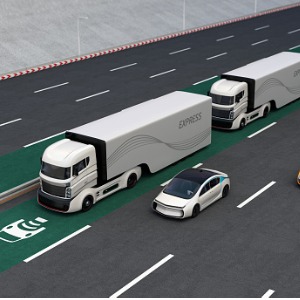A Case Study of Autonomous Trucks

Fleet of autonomous trucks driving on reserved lane (Chesky_W, iStockphoto)

Fleet of autonomous trucks driving on reserved lane (Chesky_W, iStockphoto)
How does this align with my curriculum?
Curriculum Alignment
AB
11
Knowledge and Employability Science 20-4 (2006)
Unit B: Understanding Common Energy Conversion Systems
BC
11
Physics 11 (June 2018)
Big Idea: Energy is found in different forms, is conserved, and has the ability to do work.
NU
11
Knowledge and Employability Science 20-4 (Alberta, 2006)
Unit B: Understanding Common Energy Conversion Systems
NT
11
Knowledge and Employability Science 20-4 (Alberta, 2006)
Unit B: Understanding Common Energy Conversion Systems
AB
8
Career and Technology Foundations (CTF) (revised 2019)
CTF is exploring interests, passions and skills while making personal connections to career
possibilities.
AB
8
Career and Technology Foundations (CTF) (revised 2019)
CTF is working independently and with others while exploring careers and technology.
AB
9
Career and Technology Foundations (CTF) (revised 2019)
CTF is exploring interests, passions and skills while making personal connections to career
possibilities.
AB
9
Career and Technology Foundations (CTF) (revised 2019)
CTF is working independently and with others while exploring careers and technology.
ON
11
Communications Technology, Grade 11 University/College Preparation (TGJ3M) (2009)
Strand D: Professional Practices and Career Opportunities
ON
12
Communications Technology, Grade 12 (TGJ4M) (2009)
Strand D: Professional Practices and Career Opportunities
ON
11
Computer Engineering Technology, Grade 11, University/College Preparation (TEJ3M) (2009)
Strand D: Professional Practices and Career Opportunities
ON
12
Computer Engineering Technology, Grade 12, University/College Preparation (TEJ4M) (2009)
Strand D: Professional Practices and Career Opportunities
ON
11
Transportation Technology, Grade 11, College Preparation (TTJ3C) (2009)
Strand D: Professional Practices and Career Opportunities
ON
12
Transportation Technology, Grade 12, College Preparation (TTJ4C) (2009)
Strand D: Professional Practices and Career Opportunities
ON
11
Manufacturing Engineering Technology, Grade 11, University/College Preparation (TMJ3M) (2009)
Strand D: Professional Practices and Career Opportunities
ON
12
Manufacturing Engineering Technology, Grade 12, University/College Preparation (TMJ4M) (2009)
Strand D: Professional Practices and Career Opportunities
ON
11
Hospitality and Tourism, Grade 11, College Preparation (TFJ3C)(2009)
Strand D: Professional Practices and Career Opportunities
ON
12
Hospitality and Tourism, Grade 12, College Preparation (TFJ4C) (2009)
Strand D: Professional Practices and Career Opportunities
ON
11
Health Care, Grade 11, University/College Preparation (TPJ3M) (2009)
Strand D: Professional Practices and Career Opportunities
ON
12
Health Care, Grade 12, University/College Preparation (TPJ4M) (2009)
Strand D: Professional Practices and Career Opportunities
ON
11
Hairstyling and Aesthetics, Grade 11, Workplace Preparation (TXJ3E) (2009)
Strand D: Professional Practices and Career Opportunities
ON
12
Hairstyling and Aesthetics, Grade 12, Workplace Preparation (TXJ4E) (2009)
Strand D: Professional Practices and Career Opportunities
ON
11
Green Industries, Grade 11, University/College Preparation (THJ3M) (2009)
Strand D: Professional Practices and Career Opportunities
ON
12
Green Industries, Grade 12, University/College Preparation (THJ4M) (2009)
Strand D: Professional Practices and Career Opportunities
ON
9
Exploring Technologies, Grade 9, Open (TIJ1O) (2009)
Strand D: Professional Practices and Career Opportunities
ON
11
Construction Engineering Technology, Grade 11, College Preparation (TCJ3C) (2009)
Strand E: Professional Practices and Career Opportunities
ON
12
Construction Engineering Technology, Grade 12, College Preparation (TCJ4C) (2009)
Strand E: Professional Practices and Career Opportunities
ON
10
Digital Technology and Innovations in the Changing World (2023)
B. Hardware, Software, and Innovations
BC
8
Career Education 8 (2016)
Big Idea: Our career paths reflect the personal, community, and educational choices we make.
NS
8
Science Grade 8 (2020)
Learners will analyse how the characteristics of cells relate to the needs of organisms.
NS
8
Science Grade 8 (2020)
Learners will evaluate ways to maintain and factors that disrupt cell and system health.
NU
8
Knowledge and Employability Science 8 (Alberta, Revised 2009)
Unit C: Light and Optical Systems
NU
8
Knowledge and Employability Science 8 (Alberta, Revised 2009)
Unit E: Freshwater and Saltwater Systems
YT
8
Science Grade 8 (British Columbia, June 2016)
Big Idea: Life processes are performed at the cellular level.
NT
8
Knowledge and Employability Science 8 (Alberta, Revised 2009)
Unit C: Light and Optical Systems